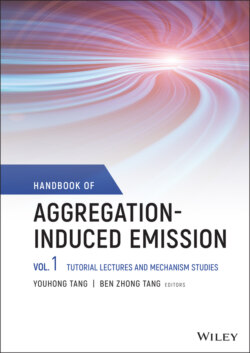Читать книгу Handbook of Aggregation-Induced Emission, Volume 1 - Группа авторов - Страница 33
2.3 Revealed AIE Mechanism
ОглавлениеAIEgens are non‐ or low‐emissive in dilute solution but highly emissive in the aggregate phase. The direct characterization of the luminescent property is the fluorescence quantum efficiency (ΦF), which is related to kr and kic by the following equation: ΦF = kr/(kr + kic). The competition between kr and kic determines the emission behavior of AIEgens. As shown in Figure 2.2a, both PESs of the ground state (S0) and first excited state (S1) in the solution are very flat; many vibrational modes with high quantum numbers are activated at high temperatures. These vibrational modes are strongly coupled with the electron, generating large reorganization energy, and different vibrational modes are mixed seriously, the so‐called dramatic DRE. Both the behaviors produce more nonradiative decay channels from the excited state to the ground state and highly speed up the nonradiative decay rate, while in the solid state, the compact molecular packing and electrostatic interactions restrict the intramolecular vibrational motions, which cause more steep PESs. Accordingly, the active vibrational modes and their corresponding mixtures become less favor, and the couplings between the electron and vibration become weak. Consequently, the nonradiative decay channels are blocked or even are removed and thus the rate is decreased significantly. A lot of calculated results demonstrate that aggregation can restrict the couplings between the electron and a great variety of molecular vibration modes, that is, various kinds of nonradiative decay channels can be hindered, such as rotating (see Figure 2.2b) [37–40], stretching [41], bending [42], flipping [43], and twisting vibrations [9, 44]. In the following, we overview the revealed AIE mechanism related to each kind of vibrational normal mode.
